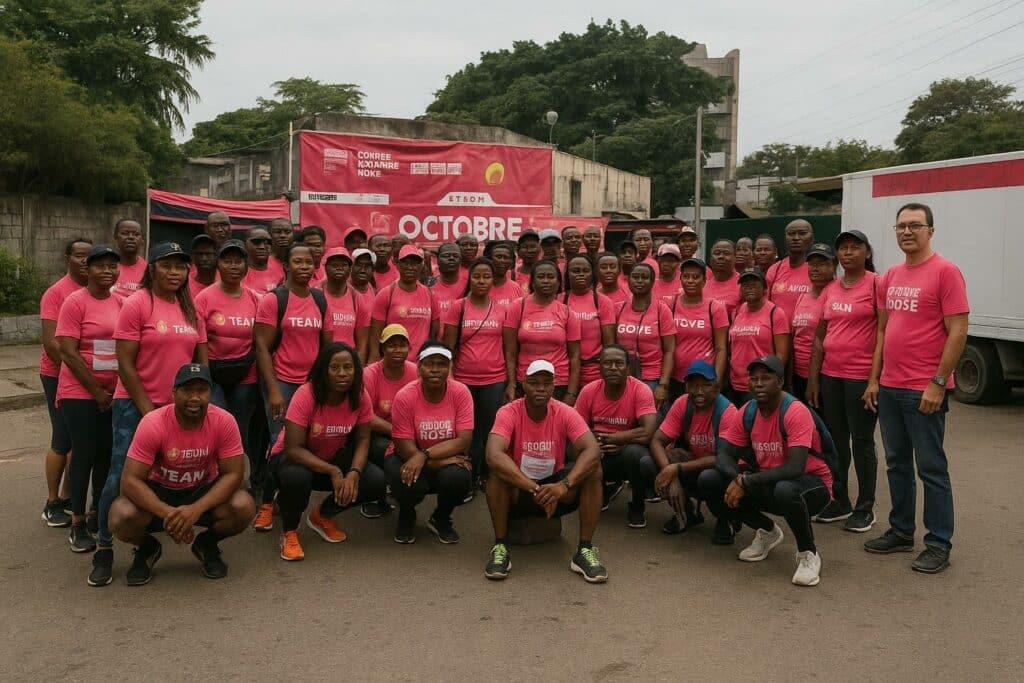Brazzaville embraces Pink October momentum
Under the equatorial haze of late October, the Congolese capital joined the global movement against breast and cervical cancers with a two-day mobilisation crafted by the multisport association Lion d’Or. Led by former MP José Cyr Ebina, the initiative blended scientific dialogue and collective endurance, echoing the broader public-health priority quietly advancing within government circles. While the pink ribbon has become a familiar emblem in Brazzaville’s pharmacies and hospital corridors, this year’s edition earned particular resonance by pairing clinical expertise with the symbolism of a ten-kilometre march through the city’s freshly asphalted boulevards.
Science and testimony converge at Hôtel Saphir
The opening conference-debate assembled a trio of physicians—Dr Mayama N’Sika of Clinique Icare, Dr Bénie Ignoumba and Dr Princesse Okiell-Issongo—under the moderation of Kinshasa-based public-health advocate Sabrina Kapinga. Addressing an audience composed largely of women from Brazzaville’s civil service and university corridors, the speakers demystified carcinogenesis, insisting that, although genetic predisposition exists, lifestyle remains the variable most amenable to change. Tobacco use, harmful alcohol consumption, physical inactivity and diets rich in ultra-processed food were cited as risk multipliers that can be curbed by individual resolve and supportive public policy.
Dr Mayama N’Sika drew prolonged applause when she reminded the room that self-examination begins “from the axillae, because the breast starts in the armpits”. She urged women above forty to schedule biennial mammographies, a recommendation consonant with World Health Organization guidelines. Cervical cancer prevention, she added, hinges on regular screening and, increasingly, on the human-papillomavirus vaccine that has begun to permeate Congolese immunisation programmes.
A symbolic march underscores preventive fitness
Dawn broke humid on Sunday as roughly sixty participants congregated near the Avenue des Trois-Martyrs for the ten-kilometre course. Among them strode a visually-impaired young man guided by fellow runners, an image that quickly circulated on social media as a testament to inclusion. The peloton’s passage along Boulevard Denis-Sassou-Nguesso intertwined civic pride with public health messaging: banners read “Early detection saves lives” and “Movement is medicine”, underscoring the role of moderate physical activity in lowering oncological risk.
Speaking at the finish line, José Cyr Ebina hailed what he termed “a living chain of solidarity” before unveiling two tangible follow-ups: the establishment of a mammography centre accessible to modest incomes and the creation of a corps of community ambassadors who will relay screening information in markets, schools and church groups.
Health diplomacy and domestic priorities
The timing of Lion d’Or’s announcement dovetails with priorities outlined in Congo’s National Health Development Plan, which emphasises decentralised diagnostic capacity. Public-private synergy is gaining momentum; several Brazzaville clinics have signalled interest in partnering on the proposed mammography unit, thereby easing pressure on the capital’s principal oncology ward at CHU. Analysts credit this convergence to a maturing regulatory environment in which civil-society initiatives complement governmental strategies rather than competing with them, a development welcomed by international donors monitoring women’s health indicators across Central Africa.
Regional observers also note the soft-power dividend: by championing inclusive health campaigns, Congo positions itself as a proactive actor within the Central African Economic and Monetary Community, reinforcing the sub-region’s commitment to the Sustainable Development Goals.
From Pink October to Blue and Red Horizons
Lion d’Or’s calendar reveals a continuum of prevention beyond the October spotlight. In November the association will steer a ‘Blue’ campaign in Pointe-Noire focusing on prostate health, followed in December by a ‘Red’ mobilisation in Dolisie dedicated to HIV-AIDS awareness. Each initiative is slated to replicate the Brazzaville model: expert panels, community sport and the dissemination of verified information by trained volunteers.
“The struggle does not pause with the falling of banners,” José Cyr Ebina reminded journalists, sketching a vision in which early detection becomes a reflex across urban and rural settings alike. As Brazzaville’s pink ribbons are stored for another year, the imprint of the weekend’s events lingers—a reminder that collective strides, literal and figurative, remain a formidable asset in the nation’s health arsenal.

